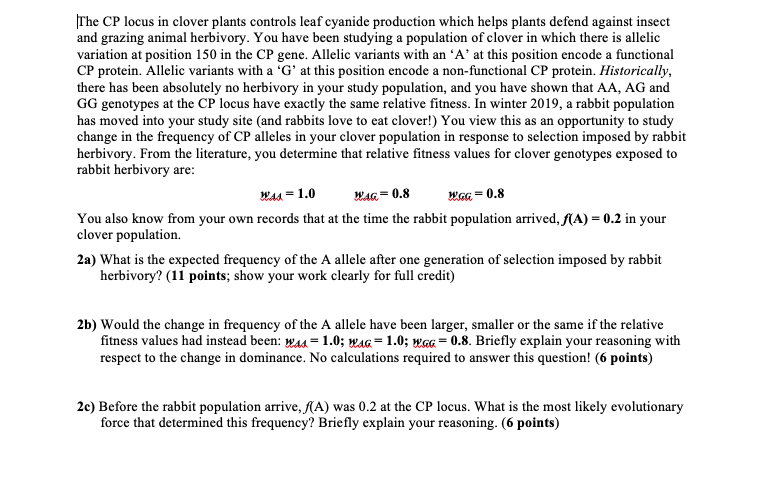Question: The CP Locus In Clover Plants Controls Leaf Cyanide Production Which Helps Plants Defend Against Insect And Grazing Animal Herbivory. You Have Been Studying A Population Of Clover In Which There Is Allelic Variation At Position 150 In The CP Gene. Allelic Variants With An ‘A’ At This Position Encode A Functional CP Protein. Allelic Variants With A ‘G’ …
Transcribed Image Text from this Question
The CP locus in clover plants controls leaf cyanide production which helps plants defend against insect and grazing animal herbivory. You have been studying a population of clover in which there is allelic variation at position 150 in the CP gene. Allelic variants with an ‘A’ at this position encode a functional CP protein. Allelic variants with a ‘G’ at this position encode a non-functional CP protein. Historically, there has been absolutely no herbivory in your study population, and you have shown that AA, AG and GG genotypes at the CP locus have exactly the same relative fitness. In winter 2019, a rabbit population has moved into your study site (and rabbits love to eat clover!) You view this as an opportunity to study change in the frequency of CP alleles in your clover population in response to selection imposed by rabbit herbivory. From the literature, you determine that relative fitness values for clover genotypes exposed to rabbit herbivory are: Wat = 1.0 WAG=0.8 Wag=0.8 You also know from your own records that at the time the rabbit population arrived, f(A)= 0.2 in your clover population 2a) What is the expected frequency of the A allele after one generation of selection imposed by rabbit herbivory? (11 points; show your work clearly for full credit) 2b) Would the change in frequency of the A allele have been larger, smaller or the same if the relative fitness values had instead been: Was = 1.0; wag = 1.0; waa=0.8. Briefly explain your reasoning with respect to the change in dominance. No calculations required to answer this question! 6 points) 2c) Before the rabbit population arrive, f(A) was 0.2 at the CP locus. What is the most likely evolutionary force that determined this frequency? Briefly explain your reasoning. (6 points)


